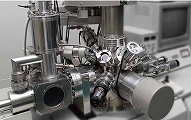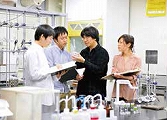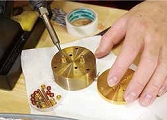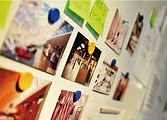| Facility Design Management laboratory |
Product Design Management laboratory |
This is a laboratory focused on the space we have at the workplace. The workplace consists of three elements: work style (organizational structure, work flow, information sharing methods, etc.), work tools (groupware, ICT tools, etc.), and the work space (physical space, office furniture, etc.). These three elements must be in harmony to create a superior workplace.
In our laboratory, we do behavioral observation based surveys looking at these three elements, clarify what issues need to be resolved and propose solutions for them, then implement the solutions and evaluate the results. By repeating these processes of survey, design and evaluation, we aim to construct a workplace design methodology that will be beneficial in real life applications. |
This laboratory researches the proliferation of design. For example, the word “design” consists of “sign”, meaning to generate or create some shape, and “de”, meaning to plan something, which when combined means to undertake a plan or project. Looking at the environment we live in from a broad perspective, we use design to research the concept planning of balanced and high value products, and then look at the successful management required during the commercialization process of those products. At design project planning, it is critical to see the surroundings and corporate image as part of the brand and design. We then conduct real-life experiential research on how to get the market to understand our plans, study the real behaviors of people, materials and money, and then how to make the plan viable as an economic activity. |
| Industrial Structures and Business Strategies laboratory |
Marketing and Life Style Design laboratory |
| There are dramatic changes occurring in the social and economic environment that corporate management must deal with, such as industry organization, structure and social systems. We focus our attention on innovation. This is one of the critical elements of a corporate environment, and we conduct our research on the impact it has on corporate management, and on ways to take effective use of it. The areas we conduct research in are macro level techno-economics and science and technology policy, as well as micro level management of technology (MOT). More specifically, in the area of techno-economics, we perform international comparisons on the level of use of information technologies and efficient methods to select government projects. In the management of technology field, we conduct research in corporate strategies such as corporate technical strategy and technology venture company start-up strategy, IP asset management including regional resources, corporate and regional management, and methods to evaluate the monetary value of technology and IP assets. |
We look at where people live their lives (customers, the market), and then survey, analyze and evaluate the users and the market at the macro and micro levels in an attempt to create our own independent strategies and concepts. The details of our research are highlighted below.
The main themes of the Kubo and Irie laboratories are design strategies that can capture the essence of the next era (universal design, eco-design) and design identity (branding), and these laboratories work on ways to raise the level of human centered design and design evaluation methodologies, production and direction. They also use core social sciences research to work on ways to review how we look at innovation and product creation.
The core focus of the Sakamoto laboratory is consumer behavior and marketing science. Their research activities focus on international comparisons and the construct of analytical models using these areas, as well as other interdisciplinary fields such as linguistics, design study and social psychology.
Graduates are active in such diverse roles as producers, planners and designers. We are also conducting collaborative research between local industry, academia and the government to help create such things as the “Kyoto Brand”, and “Kyoto Sustainable Design”. |
| Materials Evaluation Engineering laboratory |
Information Technologies and Human Interface laboratory |
We are surrounded by things that have been manufactured by industry.
In the Materials Evaluation Engineering laboratory, we conduct research on the evaluation of the characteristics of things. There are many different types of evaluation required to evaluate the characteristics of something, but we bridge evaluation of the physics and chemistry of things with human instinctive evaluation.
We have specific co-research projects with other institutes both internationally and within Japan to evaluate color. Some of the specific research we are performing is to give numerical values to the impact we receive from color and then compare these values internationally, as well as color marketing, global color communication, objective analysis of the cultural aspects of color, and color evaluation of fiber products. |
We investigate the construction of the information environment surrounding us and related user interface equipment, with the aim of achieving smooth human to human, or human to information device/system communication, as well as to realize the user interfaces that can make this happen.
If we are to create information environments matched to various communication objectives, we need to understand the interactions between the various stimulations and sensations we get from various media targeted to our five senses, and also how that media is being used. To this end we place emphasis on interaction with researchers in other fields as we conduct our own research. Some examples of the research we are conducting are the use of tactile and haptic information through vibrations, etc. in new communication methods and user interfaces; studies on the use of the visual environment for group idea generation support system; and research on collaborative work from remote locations connected by visual images. |
| Living Environment and Human Response laboratory |
|
| One characteristic of the natural lifestyle of living organisms is being awake and active during the day, and then using sleep during the night for physical and mental rejuvenation. The boundary between night and day has become quite blurred in modern society, and the natural lifestyle is subsequently under significant threat. In the Living Environment and Human Response Laboratory we use chronobiological expertise in human circadian rhythms to improve the quality of the time spent both asleep and awake. We do this by investigating the measurement and evaluation of the biological information humans emit, while also conducting research in ways to improve the biological environment we live in (light environment, etc.) as well as methods of lifestyle management. The sleep-awake rhythm is an important biological function and we are confident that research into the improvement of this function is a core area of technical research related to the design of the spaces and products we are surrounded by in our daily lives. We welcome to our laboratory all those people interested in research into the biological characteristics of human well-being. |
|
 By organically combining the three major areas of humans’ creative activities design, engineering, and management, this program places its greatest emphasis on creating “artificial objects” that blend with the living and social environment. The word “artificial objects” in this context means the products, facilities, social systems, environments, and other elements that constitute people’s lifestyles.
By organically combining the three major areas of humans’ creative activities design, engineering, and management, this program places its greatest emphasis on creating “artificial objects” that blend with the living and social environment. The word “artificial objects” in this context means the products, facilities, social systems, environments, and other elements that constitute people’s lifestyles.



